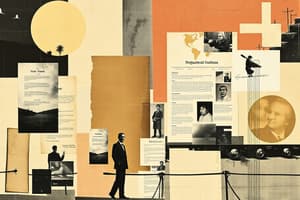Podcast
Questions and Answers
A high-performing manager assumes that plans should remain static to maintain consistency across the organization.
A high-performing manager assumes that plans should remain static to maintain consistency across the organization.
False (B)
Tactical plans and goals are established by top-level executives and outline strategies for the organization as a whole.
Tactical plans and goals are established by top-level executives and outline strategies for the organization as a whole.
False (B)
An organizational mission statement defines specific, measurable, achievable, relevant, and time-bound (SMART) objectives for the coming fiscal year.
An organizational mission statement defines specific, measurable, achievable, relevant, and time-bound (SMART) objectives for the coming fiscal year.
False (B)
Firms that strictly adhere to long-term strategic goals without adjusting to immediate environmental changes are typically the most successful.
Firms that strictly adhere to long-term strategic goals without adjusting to immediate environmental changes are typically the most successful.
Planning is most effective in a stable environment, rendering it largely ineffective in turbulent conditions.
Planning is most effective in a stable environment, rendering it largely ineffective in turbulent conditions.
Operational plans and goals are designed to achieve overall strategic outcomes, guiding major divisions and departments to contribute to the organization’s overarching purpose.
Operational plans and goals are designed to achieve overall strategic outcomes, guiding major divisions and departments to contribute to the organization’s overarching purpose.
Operational plans and goals are generated by the middle management to support overall strategic goals.
Operational plans and goals are generated by the middle management to support overall strategic goals.
Goals define how objectives will be achieved; plans specify the actual outcomes that will occur.
Goals define how objectives will be achieved; plans specify the actual outcomes that will occur.
In the planning process, defining operational goals and plans comes before crafting a mission?
In the planning process, defining operational goals and plans comes before crafting a mission?
Planning involves action of setting up organizational aims. Planning is defining the ways goals are met.
Planning involves action of setting up organizational aims. Planning is defining the ways goals are met.
Flashcards
Plan Adaptability
Plan Adaptability
Plans should adapt to changing circumstances.
Tactical Goal Responsibility
Tactical Goal Responsibility
Tactical goals and plans are set and managed by frontline managers and supervisors.
Mission Statement's Role
Mission Statement's Role
A mission statement guides the strategic level of goals and plans, influencing tactical and operational levels.
Planning in Turbulence
Planning in Turbulence
Signup and view all the flashcards
Operational plans creation
Operational plans creation
Signup and view all the flashcards
Decision-Making Models
Decision-Making Models
Signup and view all the flashcards
Optimal Solution
Optimal Solution
Signup and view all the flashcards
Administrative Decision-Making Model
Administrative Decision-Making Model
Signup and view all the flashcards
Decision Requirement
Decision Requirement
Signup and view all the flashcards
Need for Change
Need for Change
Signup and view all the flashcards
Study Notes
- Good managers understand that plans should grow and change to meet shifting conditions.
- Tactical goals and plans are the responsibility of frontline managers and supervisors.
- A desired future circumstance or condition that the organization attempts to realize is a goal.
- The mission is the basis for the strategic level of goals and plans, which in turn shapes the tactical level and the operational level.
- The most successful firms are those that react to short-term changes in the environment rather than take a flexible approach to goals and resource allocation.
- Planning cannot tame a turbulent environment.
- Operational plans and goals are those that focus on the outcomes that major divisions and departments must achieve for the organization to reach its overall goals.
- Operational plans and goals are the responsibility of middle managers.
- Goals specify today's means and plans specify future ends.
- Defining operational goals and plans occurs in the execution phase of the organizational planning process.
- Planning is the act of determining the organization's goals and defining the means for achieving them.
- The approach managers use to make decisions usually falls into one of three types, the classical model, the administrative model, or the political model.
- The best alternative solution is the one that best fits the overall goals and values of the organization and achieves the desired results using the fewest resources.
- In the real world, few decisions are certain.
- Uncertainty means that a decision has clear-cut goals and that good information is available, but the future outcomes associated with each alternative are subject to some chance of loss or failure.
- There is a greater possibility of failure with uncertainty than with risk.
- The administrative model of decision making describes how managers actually make decisions in difficult situations rather than how they should make decisions according to a theoretical ideal.
- The classical model of decision making is most useful when applied to programmed decisions and to decisions characterized by certainty or risk because relevant information is available and probabilities can be calculated.
- Not every decision situation can be organized on a scale according to the availability of information and the possibility of failure.
- Feedback is the part of monitoring that assesses whether a new decision needs to made.
- Two employees in Stacey's department quit, which is normal for her department which means she is faced with the decision to fill these positions and this would be considered a nonprogrammed decision.
- Programmed decisions involve situations that have occurred often enough to enable decision rules to be developed and applied in the future.
- Step one in the managerial decision-making process is recognition of decision requirements.
- A decision is a choice made from available alternatives.
- Managers with an analytical decision style, like to consider complex solutions based on as much data as they can gather.
- Managers confront a decision requirement in the form of either a problem or an opportunity.
- Nonprogrammed decisions typically require six steps, however, programmed decisions, being structured and well understood, typically require only one step.
- A need for change is a disparity between existing and desired performance levels.
Studying That Suits You
Use AI to generate personalized quizzes and flashcards to suit your learning preferences.




